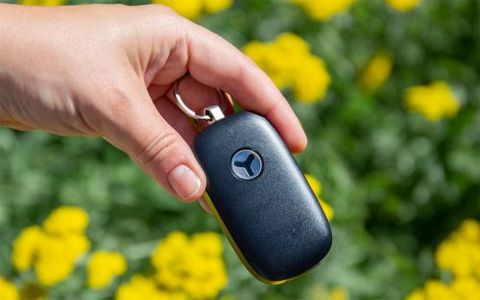While small tracking devices like the Tile Mate might be well-known and widely used, they work using a Bluetooth signal and therefore have a range. You’re most likely not going to be able to find your keys if you have no idea when they fell out of your pocket because those types of trackers depend on your being close enough to the tag for a Bluetooth signal to reach your phone. The Pocketfinder+, however, works using cell phone service, satellite and Wi-Fi, making it a lot easier to find your lost possessions no matter where you left them.
Pocketfinder+ sells a car tracker, but we opted for the personal tracker. It is oval, black and weighs only 1.3 ounces. It comes attached to a key but its size – roughly that of a large car key fob – does make it a little cumbersome, especially if you have a lot of keys or several key fobs already. There is also a string of small metal rings between the tracker and the key ring and while they didn’t break or slip loose during our tests, we could see it happening. It is splashproof, so it will survive some wear and tear.
Like most of the trackers out there, you must pay a monthly subscription to use it. Once you’ve signed up you can track your Pocketfinder+ with a free mobile app on your smart phone. If you want a tracker you can monitor via a web browser, try the Veriot Venture. The Pocketfinder+ app is easy to navigate and has both satellite and map mode and will display location pings noting what time the tracker was found at various locations. For instance, if you drove the tracker from your house and parked at your office an hour later, a ping would appear at your office noting the time and another would display at your office that said, for example, 8 a.m. The SOS alert feature is nice if the tracker user needs help and we got the notification about 30 seconds after the button was pressed.
In our tests we drove the tracker around and noticed a roughly 1-minute delay in real time tracking. You can change the settings to track in 4, 10 or 20-minute intervals if you want more battery life and don’t need constant tracking. It also randomly turned off for seemingly no reason in the middle of our tests, something we still can’t explain. We were able to turn it back on, so we know it wasn’t the battery.
And speaking of that, the battery lasted 12 hours in our tests so while that’s fine for say, a work day, several trackers we used lasted double that or more. When not moving the Pocketfinder+ goes into sleep mode to save battery but the other trackers with this function had batteries that lasted for several days, leaving us disappointed with the Pocketfinder+’s results. Using solely the map to find the hidden tracker as part of our tests, it has a discovery range of about 50 feet, a rather impressive feat. This means we were able to use the app and get 50 feet away from the tracker before we had to just look around the area for it. You can also set it up to receive alerts if your tracker crosses preset boundaries on the map, say, around your home or your child’s school.
The big downside to this tracker is we had a lot of trouble getting the charging cord it came with to work. The micro USB cable fit into the device but when plugged into a laptop we kept getting a message saying the cord wasn’t recognized. We tried several different ports and then resorted to using different cords but continued getting the error message. We also tried a wall adapter but couldn’t tell if it was charging. Another design flaw we found was the large button on the tracker. It’s unclear what it does because it’s not labeled, but when pressed the device’s small LED light illuminates certain colors noting certain functions. According to the instructions you have to press it three times, but a lot of trackers have simple power buttons that are labeled and a lot simpler to use.
Despite this, it appeared to charge because it worked when we booted it up and synced the device to the app. The app is handy to use because along with the aforementioned things, you can see how many miles you are from the tracking tag which we could imagine being convenient for knowing how long it could take to retrieve your lost possession. The Speed Limit Alert function wasn’t working at the time of our tests but presuming future activation, users should be able to receive an alert when the tracker moves faster than a set speed.


